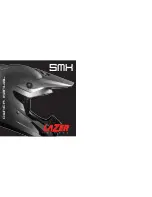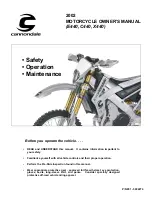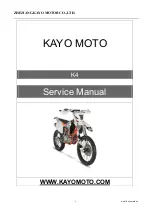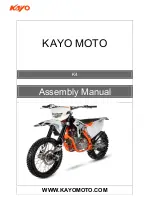
52
•
Adjust the rear brake free play
(page 47)
and drive chain slackness
(page 41)
.
•
After installing the wheel, apply the brake
several times and check for free wheel
rotation when released.
CAUTION
!
!
Always replace used split pins with new ones.
•
Park the vehicle on the level surface.
•
Check the main/side stand return spring for
damage or loss of tension.
•
Check the main stand (1)/side stand (2)
for freedom of movement.
MAIN/SIDE STAND LUBRICATION
•
Clean and lubricate the side stand pivot bolt
(3) and rear brake pedal/main stand pivot
(4)
•
Make sure the side/main stand is not bent.
(1) Main stand (2) Side stand
(3) Side stand pivot bolt
(4) Rear brake pedal/Main stand pivot
1
2
•
Using tyres that are excessively worn or
improperly inflated can cause a crash in
which you can be seriously hurt or killed.
•
Follow all instructions in this owner's
manual regarding tyres inflation and
maintenance.
WARNING
!
!
Front
Rear
80/100-18-47P (Tubeless tyre)
80/100-18-54P (Tubeless tyre)
TUBELESS TYRES
The tyres fitted on your vehicle are of
TUBELESS type.
To safely operate your vehicle, your tyres must
be of the proper type and size, in good
condition with adequate tread, and correctly
inflated for the load you are carrying.
The following pages give more detailed
information on how and when to check the air
pressure, how to inspect your tyres for
damage, and what to do when your tyres need
to be repaired or replaced.
Generally, under-inflated tyres wear unevenly,
adversely affect handling and are more likely
to fail from being overheated.
Under inflated tyres can also cause wheel
damage in rocky terrain.
Keeping your tyres properly inflated provides
the best combination of handling, tread life
and riding comfort.
Air pressure
3
4















































